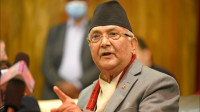National
Asymptomatic patients in home isolation in Kathmandu find themselves in limbo
They say it’s difficult for them to get counselling and tested again to ensure they are free of coronavirus.
Shuvam Dhungana
Suraj Shrestha, of Kathmandu Metropolitan-32, has been in home isolation for 15 days now. Shrestha’s office got all its employees tested for Covid-19 after a colleague was found to have been infected.
“On August 14, I also tested positive. But as I didn’t show any visible symptoms, local authorities asked me to isolate myself at home,” said Shrestha.
After his reports came in, Shrestha’s daughter, son and wife were also tested for the disease on August 15. “But luckily, their result was negative,” said Shrestha. “However, it was difficult for me to stay in home isolation as I was worried I would pass the disease on to my family members,” he said. “But we took as many precautions as we could.”
Suraj is one of the 500-odd asymptomatic Covid-infected residents of Kathmandu Metropolitan City isolating themselves at home following a government decision on August 20 to provide hospital beds only to patients with visible symptoms.
The government decision came following a surge in the number of Covid-19 cases across the country, resulting in a shortage of isolation beds in hospitals. The country has so far reported 37,340 Covid-19 cases—3,960 in Kathmandu alone, making it the district most affected by the pandemic.
According to Ishwar Man Dangol, spokesperson for Kathmandu Metropolitan City, over 500 infected people are currently staying in home isolation. “We don’t have isolation beds in Kathmandu Metropolitan City. Due to this, many people who do not meet the government criteria have to stay in home isolation,” said Dangol. “The government is preparing to set up a 2,000-bed isolation ward in the Valley soon.”
However, people isolating themselves say it is not easy for them to get in touch with health workers, receive counselling from them and get tested again after spending the prescribed two weeks in isolation.
Officials at the Ministry of Health and Population however claimed that the people who are kept in home isolation are contacted everyday by health workers of respective wards.
“Health workers assigned by the respective wards are in touch with people who test positive and they even get patients admitted to a hospital if they start showing symptoms,” said Ganesh Shrivastav, information officer at the Ministry of Health and Population.
Shrestha said he hasn’t received adequate attention from the health worker assigned by his ward. “I barely received four calls from the health worker to check on my health,” he said. “It was my office that paid to get me and my family tested again after we stayed in isolation for two weeks,” said Shrestha, who is waiting for his second test reports.
The situation Jarina and her family faced is also similar. The Koteshwor resident who tested positive along with her family on August 12, has been isolating herself. “It’s been over 16 days, my family members and I have been in home isolation and we are yet to know for how long we have to stay in home isolation,” said Jarina, who wished to identify herself by her first name only.
“I received only around six calls during this time period from a health worker from Kathmandu Metropolitan City who was asking if I had any problems.”
The last call the family received was on Friday. “During the call, I asked if we could get tested again to confirm that we’ve fully recovered. But they told me that if we didn’t show any symptoms, we don’t need to get tested, Jarina told the post.
However, Jarina and her family are worried that they might transmit the disease to others if they haven’t recovered. “All we did was stay home, we haven’t done anything for treatment,” said Jarina. “What if we test positive again?”
Shrivastav from the ministry said that health workers are telling people in home isolation they don’t need to get tested again if they don’t show symptoms. “Asymptomatic patients don’t need to get tested again if they don’t show any symptoms even after staying in home isolation for two weeks.”
Narendra Bajracharya, chief of the Urban Health Division at Kathmandu Metropolitan City, said the city has assigned 10 dedicated teams of 4-5 members to track infected persons staying in home isolation.
“However as the number of cases in Kathmandu is soaring, our health worker may not be in touch with everyone. However, we have asked them to immediately contact us if they face some problems or symptoms,” said Bajracharya.
“We have recently hired two additional doctors, who will visit patients' homes in case of emergency.”




 14.83°C Kathmandu
14.83°C Kathmandu










%20(1).jpg&w=300&height=200)



